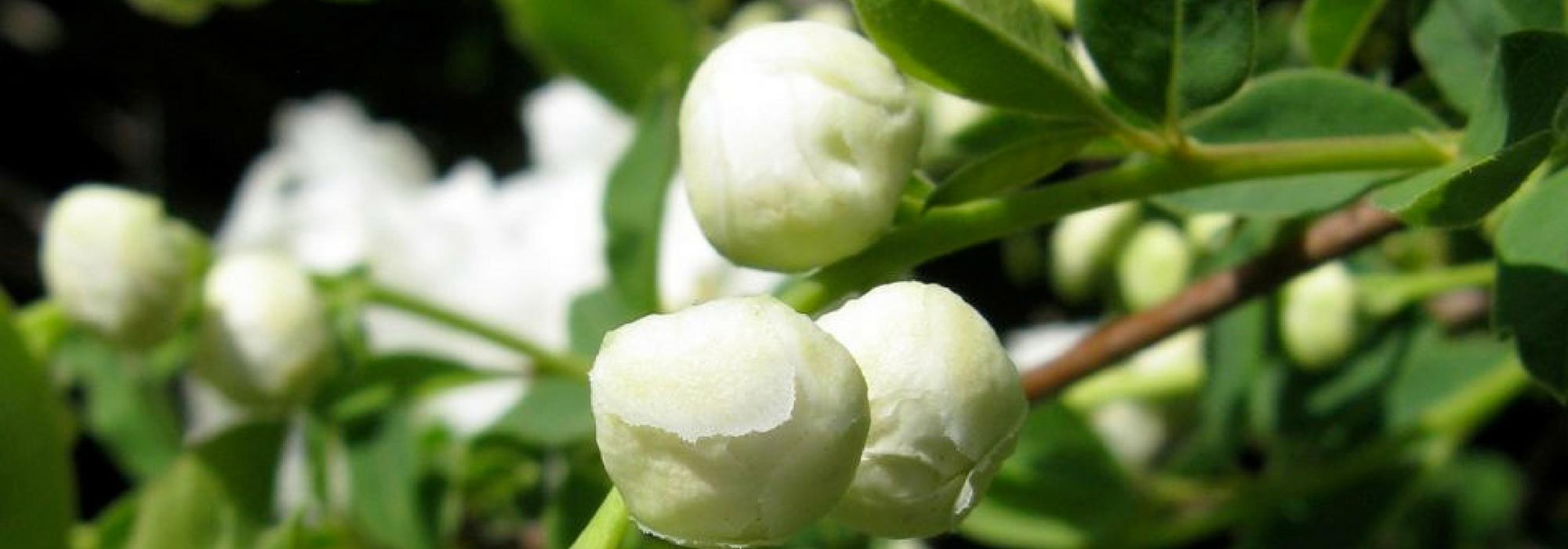
Exochorda, Pearl bush: planting, growing, pruning
Contents
Exochorda in a nutshell
- Litterally adorned with round, white, pearlescent flower buds, it is one of the most beautiful bushes of spring.
- In April-May, it is covered with a profusion of large, sparkling white flowers, reminiscent of those of the apple tree.
- It thrives in any good garden soil that is low in lime and remains cool.
- Its reasonable size makes it essential in small and medium gardens, in free hedges, as a specimen, in borders, but also in pots.
- It is a worry-free deciduous bush, hardy and resilient, easy to grow!
A word from our expert
Exochorda, also known as the “Pearl Tree” or “Pearl Bush” is undoubtedly one of the most charming bushes in spring. Unjustly overlooked, this magnificent, flexible and graceful bush truly deserves a prominent place in every garden.
And for good reason, when Exochorda is still in bud, it looks as if it is covered in sparkling pearls! Its flowering is just as breathtaking, as these buds burst open from April to May into large flowers of a lovely pure white that, in some cases, emit a delicate fruity fragrance.
From Exochorda racemosa ‘Nigara’ (or E. grandiflora), to Exochorda serratifolia ‘Snow White’, through Exochorda x macrantha ‘The Bride’ or the rarely cultivated Exochorda korolkowii, all are as easy to grow as spiraeas and require little maintenance.
Hardy and never sick, this undemanding bush is accommodating in non-burning sun, thriving in good, well-drained, and fairly cool soil that is not too calcareous.
Order your Pearl Tree online; this deciduous bush of reasonable size is a safe bet, essential in all gardens, even small ones, in free hedges as well as in borders and pots on a shaded terrace.
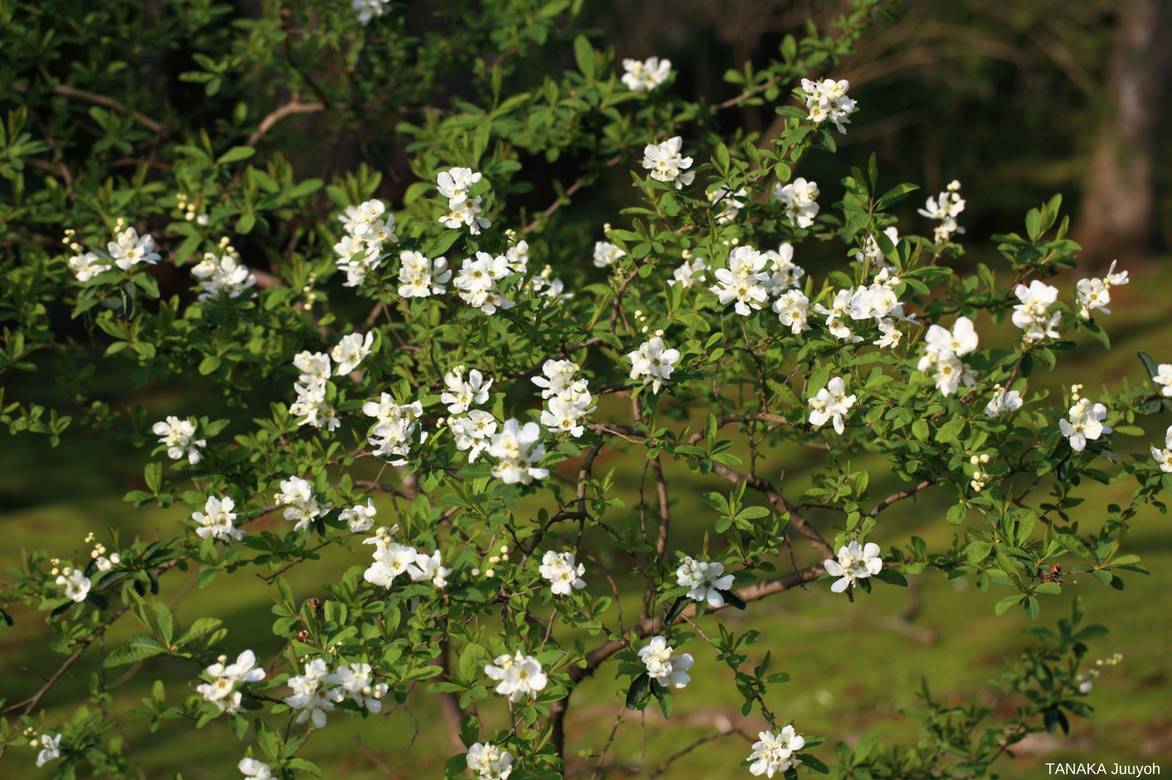
Lightness and refinement for this superb Exochorda racemosa.
Description and Botany
Botanical data
- Latin name Exochorda
- Family Rosaceae
- Common name Exochorda, Pearl Tree, Pearl Bush, Meriée Trees
- Flowering April-May
- Height 1.5 to 5 m
- Exposure Sun, partial shade
- Soil type Neutral, acidic, well-drained
- Hardiness -15°C
L‘Exochorda, often referred to as the “Pearl Tree” or the “Pearl Bush”, is an ornamental bush belonging to the Rosaceae family. It is native to the forests of Asia, particularly China.
The genus comprises four species: Exochorda racemosa (or E. grandiflora), the very first “Pearl Tree” introduced to Europe, Exochorda giraldii with slightly fragrant flowers, Exochorda serratifolia, particularly its variety ‘Snow White’, and Exochorda korolkowii, which is very rarely cultivated. Exochorda x macrantha is a hybrid form, with ‘The Bride’ being the most appreciated cultivar.
The Exochorda has a bushy habit with often loose, more or less compact, flexible, and extremely graceful branches, standing upright when young and naturally arching, giving the bush a beautiful weeping habit as it matures. It reaches a height of 1.5 to 4.5 m at maturity and tends to spread over time, often being wider than tall.
The slender, flexible branches bear small deciduous leaves that are long-petiolate, measuring 4 to 8 cm in length, alternate, simple, oblong to ovate, entire or finely dentate, sometimes ending in a small point. Their colour ranges from light to medium green, and in some species, they are covered with a fine down and darker on the underside, as seen in Exochorda racemosa.

Exochorda racemosa – botanical illustration
In Exochorda ‘The Bride’, the leaves turn a beautiful golden yellow in autumn before falling. In E. giraldii, the pale green foliage features red-tinted veins and petioles.
It is in spring that “the Pearl Bush” (Pearlbush), as the English call it, fully expresses its spectacular personality. Its abundant spring flowering is a delight even before its flowers bloom!
In April-May, its graceful young stems are adorned with a string of pure white satin floral buds, as round as mother-of-pearl beads, which earns the bush its nickname “Pearl Tree.” Gathered in terminal clusters of 6 to 10 flowers, they bloom into mostly large semi-double flowers, snow-white with pale yellow centres or green eyes.
These cup-shaped flowers measure 1 to 4 cm in diameter and consist of five petals arranged around a bouquet of stamens. The spring green foliage disappears beneath this snowy avalanche of sparkling flowers that evoke the blossoms of apple and pear trees. Like a bride’s train, the branches gracefully bend under the weight of the delicate corollas.
Its flowering branches, just beginning to bloom, will make fresh early bouquets.
While most Exochorda flowers are lightly scented, those of certain species like Exochorda giraldii emit a subtle sweet fragrance.
They transform into very strange fruits in the form of pentagonal capsules containing one to two winged seeds, although this fruiting is rare in our climates.
The name Exochorda derives from Greek, meaning “external cord,” alluding to the cord that holds the seeds.
Very hardy, Exochorda withstands temperatures down to -15 °C without flinching. It finds its place in all regions and in all small to medium gardens. It is easy to grow in non-burning sun or partial shade in well-drained, slightly acidic to neutral soil, low in lime.
It is well-suited for free hedges, as a specimen, in shrub borders, in beds, but also in containers.

Leaves, buds, flowers, and fruits of Exochorda.
Main species and varieties
The genus Exochorda includes only 4 species: Exochorda racemosa (or E. grandiflora), Exochorda serratifolia which tolerates limestone better, Exochorda korolkowii, and Exochorda giraldii which is the only fragrant one.
Most Popular
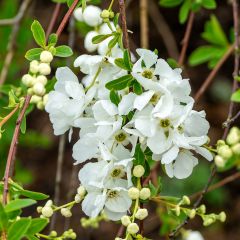
Exochorda macrantha The Bride
- Flowering time May, June
- Height at maturity 2 m
Our Favorites
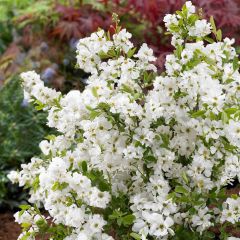
Exochorda racemosa Niagara
- Flowering time May, June
- Height at maturity 1,50 m
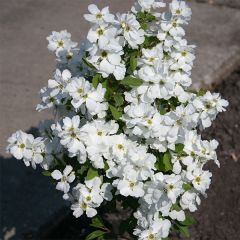
Exochorda racemosa Magical Springtime
- Flowering time June, July
- Height at maturity 1,20 m
Discover other Exochorda
View all →Available in 2 sizes
Available in 1 sizes
Available in 1 sizes
Available in 1 sizes
Available in 2 sizes
Available in 1 sizes
Available in 1 sizes
Where, when, and how to plant Exochorda?
Where to plant?
With good hardiness down to -15°C, this bush can be planted almost anywhere in France as it withstands severe cold without faltering.
Easy to please, it only fears scorching exposures, overly dry soils in summer, and excessive limestone in the soil which can lead to chlorosis of the foliage.
Prefer a sunny but not scorching exposure; in a Mediterranean climate, it is better to reserve a shaded spot for it. However, avoid too dense shade under which it will produce a more subdued flowering.
Not very demanding, while it can adapt to any good well-drained ordinary soil, it will thrive better in deep, rich, slightly acidic soils that remain cool in summer. Only a few exochordas like Exochorda serratifolia or ‘The Bride’ tolerate limestone a bit better.
Its spreading development often reaching 3 metres across the ground requires a well-cleared and bright location so it can grow freely: it needs space to spread. In a large garden, it will look stunning planted in a grove in groups of three.
With a dazzling virginal splendour for one or two months in spring, this bush falls into a certain anonymity for 10 months of the year: find it companions with evergreen foliage that will take over from the flowering.
Very versatile in the garden, it is essential in all natural gardens, in free-flowing and flowering hedges with other flowering shrubs that bloom in spring or at staggered times, to enrich the foreground or the back of a shrub mass or at the edge of perennial plants.
The Pearl Tree also gives very good results in large pots, as some varieties like Exochorda macrantha ‘The Bride’ remain quite compact and hardly exceed 1.50 m at maturity.
When to plant the Pearl Tree?
Plant the exochorda preferably in autumn, so that the plant can root quietly during winter and bloom the following spring. You can also reasonably plant in spring from February to May, after the severe cold.
How to plant an exochorda?
In open ground
Respect a planting distance of 1 m between each plant and plant in deep, low-limestone soil that is well-drained. In overly limestone soil, add heather soil at planting. To plant:
- Soak the root ball in a bucket of water for a few minutes before planting
- Loosen and clean the soil of stones or roots
- Dig a hole at least three times wider (about 50 cm in all directions) than the volume of the root ball
- Remove the pot and position the bush upright in the centre of the hole
- Backfill with the extracted soil mixed with a bucket of compost and possibly a handful of heather soil
- Firm the soil
- Spread a good organic mulch of pine bark
- Water generously with two watering cans at planting
Planting an exochorda in a pot
There are small-growing varieties of Pearl Tree well suited for pot cultivation. To install your exochorda in a pot:
- At the bottom of a pot at least 50 cm in diameter, spread a good layer of drainage (gravel or clay balls)
- Plant in 3/4 potting soil, 1/4 sand, and the rest compost
- Mulch the base and water regularly in summer to keep the root ball fresh
- Place in a terrace sheltered from direct sunlight

Some Exochorda racemosa, including the variety ‘Magical Springtime’, can be grown in a large pot.
Pruning and care
Do not be misled by its somewhat frail appearance when you receive it in a container: it is just waiting to be planted in the ground and watered regularly during the first summers to show its vigour.
Exochorda requires little attention. Monitor its water needs in summer. This bush is sensitive to dry soil: it can adapt to dry gardens with good organic mulching or a layer of well-matured compost to be renewed at the end of June to keep its roots cool during the summer heat. During the growing season, water twice a week.
Afterwards, it will become more drought-resistant and will only require watering in cases of prolonged heatwaves. For the rest of the year, it will be forgotten!
In pots, water as soon as the soil becomes dry. Allow the substrate to dry well between waterings. You can add compost to the surface in autumn.
When and how to prune an exochorda
After flowering, light pruning is recommended to give the vegetation a nice shape and remove the spent branches.
- Each year, cut back the flowering branches by a third just above an eye
- Well aerate the centre of the branches
- With pruning shears, remove dead or thin wood, and tangled branches that disrupt the habit
- Every two or three years, cut back 1/4 of the oldest and lowest branches to the base; this will encourage the bush to produce new shoots and prevent it from becoming bare at the base
Diseases and potential pests
Robust and sturdy, ‘Exochorda is resistant to diseases. In overly calcareous soil, it may, however, be susceptible to chlorosis, which causes discoloration and yellowing of the leaves. The culprit may simply be the watering water; prefer to water with rainwater. Optionally, top-dress with acidic additions of turf or heather soil.
Multiplication: propagation by cuttings
Propagation by cuttings of the Pearl Tree is not easy and success is uncertain! Propagate it in June-July just after flowering.
To propagate your exochorda:
- Cut 10 to 15 cm long young shoots with a heel
- Remove all the lower leaves, keeping a few leaves at the tip
- Be sure to dip the stems in plant hormones
- Plant these cuttings with heel in a light and draining substrate of potting soil and sand
- Moisten regularly
- Place the buckets in the shade
- Overwinter them in a frost-free environment under a well-sheltered frame
- Repot individually in spring and then plant out in the ground in autumn, one year later
Associating in the garden
This vigorous deciduous bush forms a truly sensational bush of arching branches in spring, when it is covered in floral buds followed by large white flowers. It is essential in a fresh garden, adding a touch that is both natural and feminine. It is an exceptional subject in a white garden.
Its elegant habit allows it to be planted alone, under which you can create carpets of spring bulbs with ipheions, cyclamens, and white muscaris, hyacinths, daffodils, or chionodoxas.
With its reasonable size and beautiful appearance, it is easy to associate in a free and flowering hedge with other deciduous or evergreen spring-flowering shrubs such as weigela, spiraea, pieris, amelanchier, Japanese quince, osmanthus, kerria, photinia, deutzia, garden mock-orange, lilac, Buddleias, ceanothus, and old roses will take over the flowering once the flowers of the Exochorda have faded.
Avoid overly contrasting associations with warm colours; its virginal hue will blend better with pastel shades, soft pink or pale blue.
In large romantic beds, it will be the ideal companion for magnolias, the anemone tree, and columbines, astrantias, brunneras, hardy geraniums, campanulas, daylilies, and peonies.
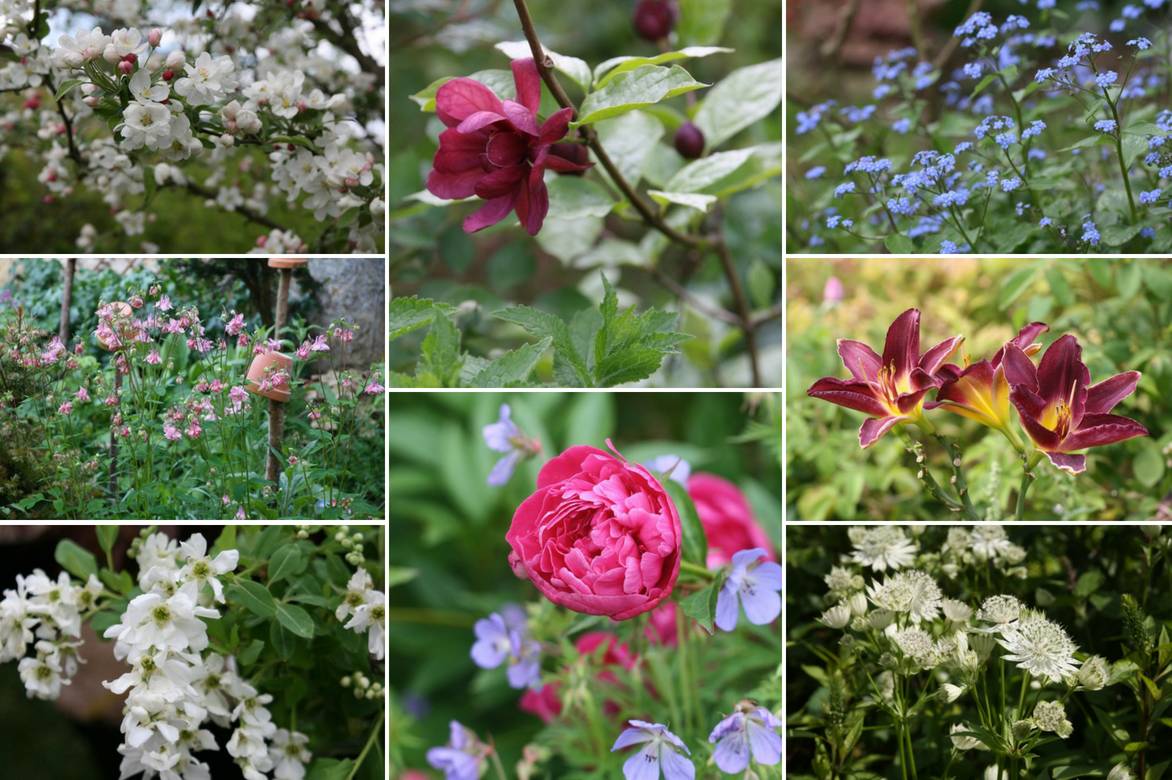
An example of association in a romantic bed: Malus ‘Evereste’, Aquilegia, Exochorda macrantha ‘The Bride’, Calycanthus raulstonii ‘Hartlage Wine’, Paeonia ‘Félix Crousse’ and hardy geranium, Brunnera macrophylla ‘Jack Frost’, Hemerocallis ‘Pardon me’, Astrantia major ‘Shaggy’. (Photos Virginie Douce, except for Exochorda).
Place the pearl tree in the foreground ofa hedge of dark evergreen shrubs such as conifers, laurel tin which will contrast beautifully with its snow-white flowers.
In pots, plant a few spring bulbs that flower blue or yellow (crocus, muscaris, hyacinths) at its base to provide a lovely contrast.
Useful resources
- Discover all our flowering hedge bushes
- How to prevent and treat chlorosis? All Virginie’s tips are on our blog!
- The Pearl Tree is a must-have in a romantic garden or in a chic garden, discover which plants to easily pair it with
- Discover our ideas to pair exochorda.
Frequently asked questions
-
Why are the leaves of my Pearl Tree turning yellow?
Exochorda is not fond of limestone, and in case of excess, its leaves discolour and turn yellow: it then suffers from chlorosis. Water only with rainwater and feed it annually on the surface with decomposed compost and leaf mould. If the foliage continues to show chlorosis, transplant it during winter to a location free of limestone.
-
Can I still plant an Exochorda in my garden if I have slightly chalky soil?
Yes, it is somewhat more accommodating than heather soil shrubs like rhododendrons or camellias. There is at least one species that tolerates calcareous soils, Exochorda serratifolia. The hybrid 'The Bride' also seems to withstand slightly calcareous soil. When planting, improve the soil with a mixture of heather soil or turf. However, if your soil is too calcareous, consider opting for a bush, otherwise you will have to frequently add heather soil, and the only reward you will get is a weak specimen that is prone to chlorosis.
- Subscribe!
- Contents

































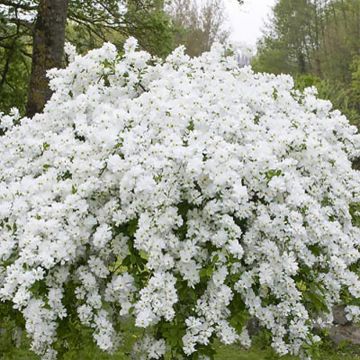
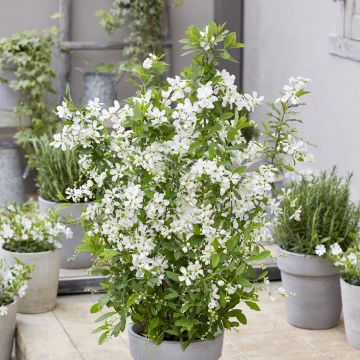


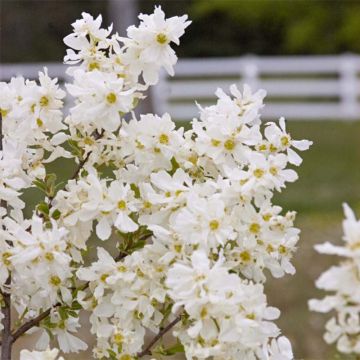
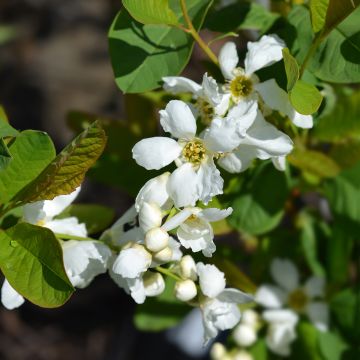
Comments